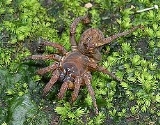
Kimura-gumo
Encyclopedia
The kimura-gumo or kimura spider (Heptathela kimurai) is an Old World
spider
, found primarily in Japan
and named after Kimura Arika, who discovered it in 1920. It belongs to the sub-order Mesothelae
(primitive burrowing spiders) and can reach up to 3 cm in length. Its burrows are covered by a camouflaged "pill box" flap.
The ancestral traits of the Kimura-gumo include central spinnerets and signs of segmentation
on the abdomen
. These features are not seen on modern spiders
, thus studying the Kimura-gumo can shed light on the evolution of all spiders.
Although kimura spiders lack venom glands, they still have strong chelicerae
and can produce quite painful biteshttp://research.amnh.org/entomology/spiders/catalog/LIPHISTIIDAE.html.
 The word kumo in Japanese
The word kumo in Japanese
means spider. ("Gumo" is a variation in pronunciation due to a phenomenon known as rendaku
.) The sub-order this spider is a member of, Mesothelae, is about 400 million years old, placing the kimura spider among the most primitive living spiders. Its spinnerets are located in the middle of the body, as opposed to the more efficient location in modern spiders at the rear of the abdomen. It fixes its eggs on the surface of its burrow with silk
so that they are well protected. The spider surrounds tunnels also with a cobweb. When it sets out on a hunt, it pays out a line of silk behind it. This "lifeline" helps it in orienting itself.
There are a number of Heptathela kimurai subspecies
including; H. k. amamiensis, H. k. higoensis, H. k. yanbaruensis and H. k. yakushimaensis http://research.amnh.org/entomology/spiders/catalog/LIPHISTIIDAE.html.
Old World
The Old World consists of those parts of the world known to classical antiquity and the European Middle Ages. It is used in the context of, and contrast with, the "New World" ....
spider
Spider
Spiders are air-breathing arthropods that have eight legs, and chelicerae with fangs that inject venom. They are the largest order of arachnids and rank seventh in total species diversity among all other groups of organisms...
, found primarily in Japan
Japan
Japan is an island nation in East Asia. Located in the Pacific Ocean, it lies to the east of the Sea of Japan, China, North Korea, South Korea and Russia, stretching from the Sea of Okhotsk in the north to the East China Sea and Taiwan in the south...
and named after Kimura Arika, who discovered it in 1920. It belongs to the sub-order Mesothelae
Mesothelae
The Mesothelae are a suborder of spiders that includes the extinct families Arthrolycosidae and Arthromygalidae and the only extant family Liphistiidae....
(primitive burrowing spiders) and can reach up to 3 cm in length. Its burrows are covered by a camouflaged "pill box" flap.
The ancestral traits of the Kimura-gumo include central spinnerets and signs of segmentation
Segmentation (biology)
Segmentation in biology refers to either a type of gastrointestinal motility or the division of some animal and plant body plans into a series of repetitive segments. This article will focus on the segmentation of animal body plans, specifically using the examples of the phyla Arthropoda,...
on the abdomen
Abdomen
In vertebrates such as mammals the abdomen constitutes the part of the body between the thorax and pelvis. The region enclosed by the abdomen is termed the abdominal cavity...
. These features are not seen on modern spiders
Araneomorphae
The Araneomorphae are a suborder of spiders. They are distinguished by having fangs that oppose each other and cross in a pinching action, in contrast to the Mygalomorphae , which have fangs that are nearly parallel in alignment.- Distinguishing characteristics :Note the difference in the...
, thus studying the Kimura-gumo can shed light on the evolution of all spiders.
Although kimura spiders lack venom glands, they still have strong chelicerae
Chelicerae
The chelicerae are mouthparts of the Chelicerata, an arthropod subphylum that includes arachnids, Merostomata , and Pycnogonida . Chelicerae are pointed appendages which are used to grasp food, and are found in place of the chewing mandibles most other arthropods have...
and can produce quite painful biteshttp://research.amnh.org/entomology/spiders/catalog/LIPHISTIIDAE.html.

Japanese language
is a language spoken by over 130 million people in Japan and in Japanese emigrant communities. It is a member of the Japonic language family, which has a number of proposed relationships with other languages, none of which has gained wide acceptance among historical linguists .Japanese is an...
means spider. ("Gumo" is a variation in pronunciation due to a phenomenon known as rendaku
Rendaku
is a phenomenon in Japanese morphophonology that governs the voicing of the initial consonant of the non-initial portion of a compound or prefixed word...
.) The sub-order this spider is a member of, Mesothelae, is about 400 million years old, placing the kimura spider among the most primitive living spiders. Its spinnerets are located in the middle of the body, as opposed to the more efficient location in modern spiders at the rear of the abdomen. It fixes its eggs on the surface of its burrow with silk
Spider silk
Spider silk is a protein fiber spun by spiders. Spiders use their silk to make webs or other structures, which function as nets to catch other animals, or as nests or cocoons for protection for their offspring...
so that they are well protected. The spider surrounds tunnels also with a cobweb. When it sets out on a hunt, it pays out a line of silk behind it. This "lifeline" helps it in orienting itself.
There are a number of Heptathela kimurai subspecies
Subspecies
Subspecies in biological classification, is either a taxonomic rank subordinate to species, ora taxonomic unit in that rank . A subspecies cannot be recognized in isolation: a species will either be recognized as having no subspecies at all or two or more, never just one...
including; H. k. amamiensis, H. k. higoensis, H. k. yanbaruensis and H. k. yakushimaensis http://research.amnh.org/entomology/spiders/catalog/LIPHISTIIDAE.html.

